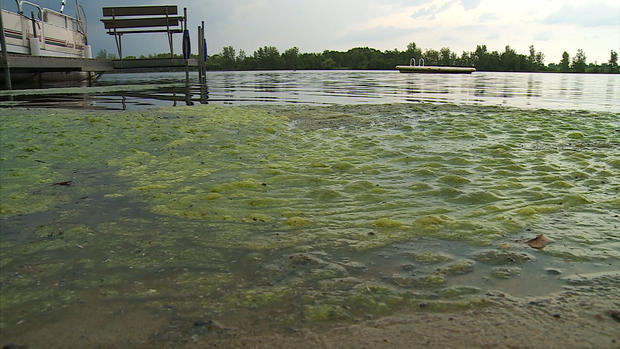Researchers Hope To Predict Blue-Green Algae Outbreaks
CENTERVILLE, Minn. (WCCO) -- A pair of bald eagles take flight in a moment of summer solitude over the waters of Peltier Lake.
But while the small body of water in Anoka County appears to be beautiful – it is far from pristine.
"I've noticed it green, but I don't know it was blue-green algae," said resident Jerome Thill.
He has lived along the lake's east shore for 25 years. Like many of its lake residents, he occasionally notices the dense, foul-smelling algae blooms that appear in the late summer.
"It gets green and all icky," Thill said. "My brother-in-law had a boat out here for a while. We took it out, the bottom was just caked in green. It gets green towards the end of summer."
Peltier is among six Minnesota lakes currently being studied for the conditions that produce blue-green algae.
The dense green mats mostly flourish in warm, nutrient-rich waters.
Not only is blue-green algae ugly to look at -- it is downright deadly.
According to state reports, it is responsible for killing at least 20 dogs since 2004.
In addition, a number of people have become sickened as well, suffering from diarrhea, vomiting, stomach cramps, nausea and muscle pain.
Known as cyanobacteria, the algae puts out dangerous toxins which can attack the liver, kidneys and central nervous system.
Pets do not have to ingest large quantities of water containing the toxins for the poisoning to be fatal.
"It's hard to know exactly when the toxins are in the water," said research scientist Matt Lindon from the Minnesota Pollution Control Agency. "The toxins are kind of produced by the algae, so it's not the easiest thing to predict."
But researchers are working to change that. Lindon cautions lake goers that if there's any doubt, stay out.
"The greatest chances of kind of risk and exposure is when you see it very dense," he said. "The thicker the green, probably the biggest concern."
Visually, blue-green algae will appear as a thick pea soup, or spilled green paint floating on the water surface.
Consumers can purchase simple, low-cost test strips that will indicated the presence of certain toxins in the water.
However, experts caution those tests have not proven 100-percent effective and can give a false sense of security if the algae is forming.




